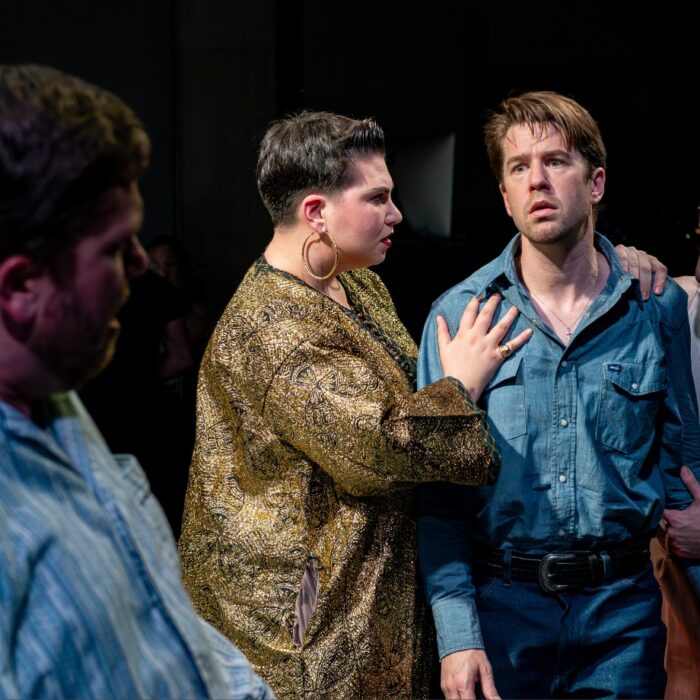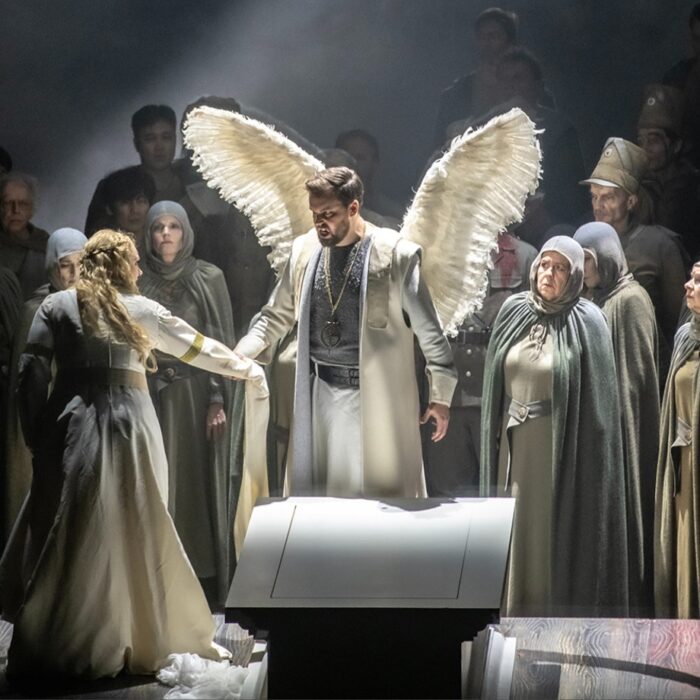
CD Review: Marina Rebeka’s ‘Spirito’
Latvian Soprano Presents Five Dramatically & Musically Insightful Interpretations Of Bellini, Donizetti & Spontini
By Francisco SalazarIt’s hard to find the right voice for the Bel Canto repertoire. A great Bel Canto singer needs flexibility, bright high notes, immense breath control, and impeccable phrasing. And of course, a singer needs to have great command of expression, otherwise, the music can easily fall flat. Many singers attempt to put all this together, but few actually have the complete package, excelling in some aspects but not necessarily in all of them.
In Marina Rebeka’s latest album “Spirito” the Latvian soprano proves that she is not only in top form and at the prime of her career but a great exponent of this repertoire, bringing five Bel canto scenes with immaculate control and depth performances.
Before The Good Stuff…
Before I write about how great this album, I do have a couple of qualms with it. First off the balance in some of the tracks between orchestra and singer is not always good. In particular “Ah! Bello a me ritorna” from “Norma” suffers from this. In the interlude between the repeat of the cabaletta, the orchestra feels distant from the chorus, making the intended crescendo feel incredibly dead on arrival. And in the coda, the same thing happens, making the cabaletta’s climax lack the build that Bellini intended for the piece.
The other issue with the album is Spontini’s “La Vestale.” Rebeka’s inclusion in the work is a bold choice and one that allows this work to get visibility. While Spontini belongs to the same period as Donizetti and Bellini, musically, these tracks feel a bit out of place especially when the complete album is in Italian save for the last four tracks, which are in French. The style of the scene is also more reminiscent to that of Mozart’s music as opposed to Donizetti and Bellini’s. Perhaps if there would have been more variation of language within the album, this particular scene would have had greater impact.
One might be able to justify the passage’s movement toward a ferocious second aria, which mirrors every other scena by Bellini and Donizetti, but the music itself simply feels of a different style; in this context, it just feels strange and repeat listens have not been able to shake this sense. Nevertheless, Rebeka does perform this scene with technical mastery. More on that later.
The final issue is the end of “Coppia Iniqua.” While Rebeka is solid throughout the entire track the slight pause to allow Rebeka to rise to an E Flat kills the climax of the piece and Rebeka’s hesitance at the beginning of the phrase before the E Flat is quite awkward. The E Flat, which was never written by Donizetti, is also thin and doesn’t really ring.
Vibrant Bellini
But besides these three minor issues, there is a lot to look forward to. First and foremost Rebeka used the original manuscripts when recording the album making sure that not one note was cut from each scene. From there she created her own ornamentations to give her own take and interpretation on the composer’s original intentions.
The CD gets off to an impressive start with a refined account of “Casta Diva” from “Norma.” Rebeka begins the opening phrases with a mezzo piano singing with control and clear tone. As the aria develops, she begins to build each phrase, crescendoing to a forte before decrescendoing to begin the repeat. However, in the B section, Rebeka spins the coloratura line with delicacy before beginning the second verse. Unlike the first verse, Rebeka takes some time extending some of the phrases to give the line variations, particularly in the cadenza.
In the subsequent recitative, the soprano’s tone changes to obtain a more authoritative sound and shows off her chest voice. But she returns to the gentler side in “Ah! bello a me ritorna.” She begins the cabaletta with tender vocalization, shifting from a delicate timbre to an imposing one. Rebeka here has total control of the coloratura line, giving each note clarity. Only in the coda of the piece is a noticeable strain and the final C is a bit pushed.
The second scene comes from the finale of “Il Pirata” where Rebeka gives the opening recitative a sense of yearning that immediately turns into delirium. The notes are given shorter phrasing and the pianissimo gasps turn to full-toned outcries. Then the accompanied phrasings with the oboe are given a nostalgic feel that rises again to forte before eventually entering into the full aria “Col sorriso d’innocenza.” Like “Casta Diva” this aria is filled with long extended lines and Rebeka floats each phrase with care and precision. Her impressive diminuendos from her fortes are beautifully controlled and represent’s Imogene’s anguish and madness.
In the opening of the cabaletta “Oh! Sole! Ti Vela di tenebre oscure,” there is an aggressive tone and Rebeka has no qualms in showing the uglier side. Her “tenebre oscure” is sung with a deeper chest voice and with shorter accented notes. That is then contrasted with a lighter timbre accompanied by the oboe. In the second repeat, Rebeka starts the phrases “O! Sole!” with a softer and hesitant tone. That is then contrasted with a sweeter voice in the coloratura runs. It then climaxes with a full tone with Rebeka interpolating numerous high notes. The numerous changes of tone only enhance the experience of the character and allow audiences to get a vivid rendition of Imogene’s madness.
The Tragic Donizetti
The following scene from Donizetti’s “Maria Stuarda” gives audiences another perspective of Rebeka’s artistry. Here Rebeka begins with the prayer “Deh! Tu di un umile pregiera,” accompanied by the chorus. There is authority and elegance in her reading. Her tone initiates with a constant mezzo forte that eventually is scaled-back to give her character vulnerability. This is best exemplified by her extended B Flat which is accompanied beautifully by the cellos, the soprano’s sound crescendoing to a forte. Towards the end of the prayer that regal queen betrays a sense of desperation, adding tension to what follows in the aria “Di un cor que muore.” One can sense nostalgia as a result of her droopy phrasing to begin the piece but then she regains a sense of strength as Rebeka and the orchestra drive the aria forward with a buoyant tempo. Her final lines, however, regain emotional hesitance as she sings the final “Cancelero.”
Then comes “Ah! se un giorno da queste ritorte,” which features a darker shading in the timbre, emphasizing a saddened state that emphasizes Maria Stuarda’s fear at seeing Percy for the last time. The second repeat only adds to that, her voice reminiscent of sobs and taking on a more hushed quality. But Rebeka doesn’t see Maria Stuarda as a defeated queen. She is commanding on the phrases “Flagello punitor,” giving each repetition more accented phrasing. The scene is given extra dramatic intensity with Marco Ciaponi’s desperate “Percy,” sung such an ardent and bright tone.
“Anna Bolena’s” mad scene follows and Rebeka’s reading is filled with great contrast. Her interpretation gives the idea of a queen torn as she begins with sweetness, then a sense of fear for her impending doom, especially on the words “Mi perdona.” Her “O Gioia” that ends the recitative begins with an outburst of happiness but as she repeats the words they turn to sorrow.
The aria “Al Dolci guidami,” in which Anna Bolena remembers her infancy is sung with that looking back. As she navigates the aria, Rebeka holds onto certain lines a bit longer, almost as trying to hold on to them forever. There is this push-pull dynamic with the tempo, which suggests an internal conflict of looking back despite a desire to move on. This is emphasized during the middle of the aria as the soprano pushes the tempo forward slightly only to rein it in moments later.
The one thing missing from this scene is the subsequent quartet. It moves to the banda march in which Rebeka’s Bolena recovers from the delirium and with her “Tacete,” this Anna Bolena regains her strength and the lines “Versato sara” are sung with power.
The subsequent “Coppia Iniqua” is sung with a mix of anger and anguish. Rebeka attacks the opening with full power but the interlude between the repeat shows a cry of desperation. Each “Tacete, Cessate” is like an outcry for help against her destiny. Before the repeat, the three “Si’s” are phrased differently. One is hesitant, one has greater strength, and the last with resignation. That anger repeats in the second “Coppia Iniqua” with Rebeka giving extra force and with a number of interpolated variations.
This differentiation of phrasing in this aria, especially, isn’t just some show of musical sophistication or empty bravura, but instead suggests the complexity of the character’s emotions in her dying moments, thus giving the performance personality and a sense of emotional immersion.
Odd Man Out, But Still Fascinating
The final scene in the album comes from “La Vestale” by Spontini. The scene, which is divided up into four tracks, begins with a solemn “O des Infortunes” which Rebeka sings with a smooth legato line that brings out the sadness in the piece.
The following arias “Toi, que j’implore avec effroi” begins with a sunnier orchestration that is reminiscent of Mozart. The orchestra eventually takes a darker color as the soprano begins with the tragic feel similar to the preceding aria. Conductor Jader Bignamini is particularly impressive in accompanying this piece, emphasizing the rhythmic touches in Sponitni’s music and allowing the soloists, especially the horns and clarinets, to get the necessary spotlight. Rebeka’s voice is more delicate and displays a greater sense of polish and rigidity in its approach, depending more on the contrasting dynamics of the piece to express the pain of the passage.
Her subsequent recitative, which connects from the aria to the final part “Imitoyables Dieux,” presents yet another portrait of anger and inner strength that concludes the album. But “Imitoyables Dieux” is also given a mix of vulnerability as Rebeka brings in that sweeter timbre and later contrasts it with full voice and a climactic High C.
Leading the Orchestra and Chorus del Teatro Massimo di Palermo, Maestro Biganamini showcases control and understanding of the style of each of the three composers. In the Bellini, he gives the extended melodies a flow almost like neverending waves moving the melodies forward. The three-quarter time throughout the Donizetti is given flexibility so that the soprano can to find the different emotional layers of each scene. Bignamini also gives force to Donizetti’s climaxes, allowing audiences the experience of his real dramatic genius. Finally, in the Spontini, Bignamini balances the romanticism of the first and second aria with the more classic feel of the final passage.
All in all, this a must buy CD for any Bel Canto lover. Marina Rebeka showcases that she is a fine interpreter of the Bel Canto style who not only understands the vocal necessities, but also the dramatic implications of the music. She is undeniably an artist capable of compelling in these roles she has outlined in this very album. One only hopes that every major theater gets the memo and brings her to do more Bel Canto in the future.


